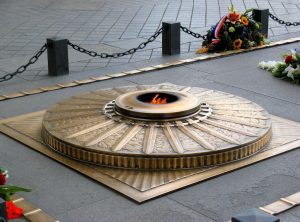After the First World War, the Unknown Soldier was chosen in Verdun on November 9, 1920, in the heart of the subterranean Citadel. One unknown soldier was chosen to represent all the soldiers who fell in battle but were never found. With the Unknown Soldier, France wanted to pay tribute to all the French victims of the Great War. Initially, nine randomly selected graves from nine battlefields on the Western Front were transported. However, doubt about the nationality of the soldier’s body in one of the graves reduced their number to eight.
On November 10, 1920, the Minister of Pensions, André Maginot, left Paris to preside over the ceremony. As he handed a bouquet of flowers to Auguste Thin, a young corporal of the 132nd regiment who had been chosen the day before to select the Unknown Soldier, he said: “Soldier, you are going to place it on one of the eight coffins that will be the Unknown Soldier […]. This is the supreme homage, it is the least we can do for those whose anonymous sacrifice and superhuman courage saved the Fatherland, the Right and the Freedom”.
The young corporal finally stopped at the 6th coffin. He explained his choice by saying that he wanted to pay tribute to his regiment (132nd). By adding up all the numbers (1+3+2), he got the number 6. The Unknown Soldier now rests in Paris.
It is possible to relive the Verdun ceremony during the immersive experience proposed today at the Citadelle of Verdun.

Do you have information about events experienced by your family during the world wars? By sharing your story, you will enrich our “Drawing inspiration from heroes” section.